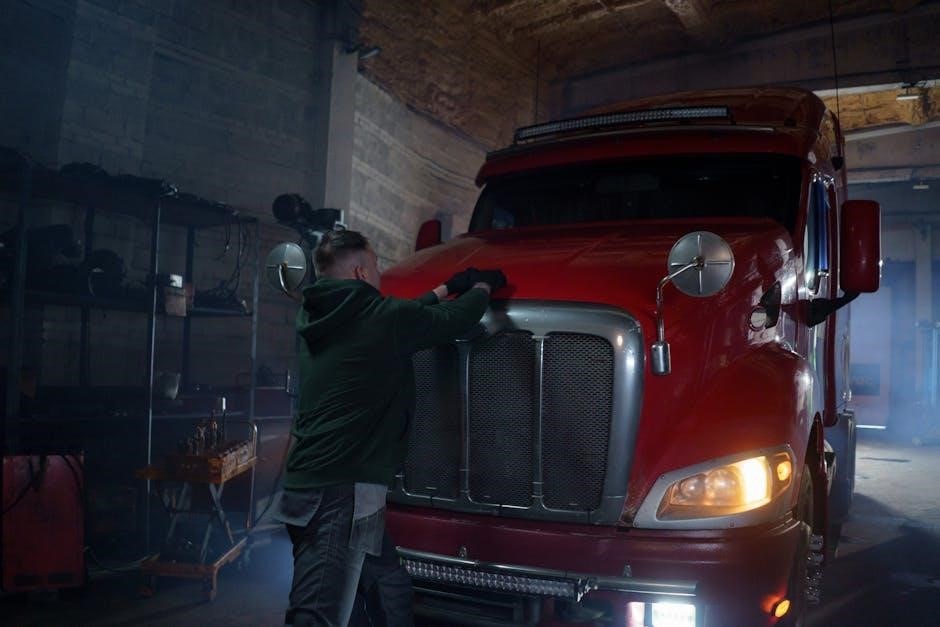Semi-truck transmissions play a critical role in performance and efficiency. While many semi-trucks are manual, the industry is shifting toward automatic transmissions for improved ease and fuel efficiency.

Evolution of Semi-Truck Transmissions
Historically, manual transmissions dominated, offering control and durability. Modern advancements have shifted toward automatic and automated manual transmissions, enhancing efficiency, reducing fatigue, and improving fuel economy significantly.
Historical Overview of Manual Transmissions
Manual transmissions have historically been the standard in semi-trucks, offering direct control and durability. For decades, they provided reliability in handling heavy loads and diverse terrains. Drivers valued the ability to optimize gear shifts for specific conditions, enhancing performance and fuel efficiency when operated by skilled professionals. However, the need for manual shifting required extensive training and experience, creating a barrier for new drivers. Despite their advantages, the industry has increasingly shifted toward automatic transmissions, driven by advancements in technology and the demand for easier operation.
Emergence of Automatic Transmissions in the Trucking Industry
Automatic transmissions have gained prominence in the trucking industry due to advancements in technology and shifting driver preferences. Modern automatics offer ease of use, reduced driver fatigue, and improved fuel efficiency, making them ideal for long-haul routes. Fleets increasingly favor automatics for their ability to handle heavy loads and adapt to varying road conditions through predictive shifting. With over 90% of new semi-trucks now featuring automatic transmissions, they are becoming the standard, driven by demand for efficiency and simplified operation in a competitive market.

Manual vs. Automatic Semi-Truck Transmissions
Semi-trucks can feature either manual or automatic transmissions, with the choice influenced by factors like driver preference, company needs, terrain, freight type, and budget. While manuals offer greater control and lower maintenance costs, automatics provide ease of use, reduced driver fatigue, and improved fuel efficiency, making them increasingly popular in the industry.
Pros of Manual Transmissions
Manual transmissions offer direct control over gear shifts, allowing experienced drivers to optimize performance based on road conditions and load demands. This control is especially beneficial for navigating steep grades, inclement weather, and maximizing power in demanding situations. Manuals are also generally more cost-effective, with lower maintenance costs and a longer lifespan due to their simpler design. Additionally, manual transmissions provide a sense of connection to the truck, appealing to drivers who value precision and hands-on operation.
Pros of Automatic Transmissions
Automatic transmissions simplify driving, reducing driver fatigue and easing operation in stop-and-go traffic. They offer improved fuel efficiency due to advanced software optimizing gear shifts. Automatics appeal to a broader range of drivers, including less experienced ones, as they eliminate the need for manual clutch operation. This reduces wear on the drivetrain and enhances ease of use. Additionally, automatic transmissions are preferred by younger drivers and fleets seeking to expand their hiring pool, as they make trucks more accessible and reduce the learning curve for new operators.
Key Differences Between Manual and Automatic
The primary distinction lies in driver involvement and ease of operation. Manual transmissions require skillful gear shifting using a clutch pedal, offering direct control over speed and torque. In contrast, automatic transmissions automate gear changes, eliminating the need for manual intervention. Manuals provide better fuel economy when driven by experienced operators, while automatics enhance comfort and reduce driver fatigue. Maintenance costs differ too, with manuals typically being cheaper to maintain long-term. These differences influence choices based on driver preference, terrain, and operational needs.
Fuel Efficiency Comparison
Manual transmissions traditionally offer better fuel economy, especially with skilled drivers, while modern automatics narrow the gap through advanced software and predictive shifting technologies.
Fuel Economy in Manual Transmissions
Manual transmissions typically offer better fuel economy due to direct driver control over gear shifts, optimizing performance based on road conditions and load. Skilled drivers can maximize efficiency by precisely timing shifts, reducing unnecessary fuel consumption. However, human error, such as improper shifting, can negate these benefits, especially with less experienced operators. While manuals historically excel in fuel efficiency, advancements in automatic transmissions have narrowed the gap, making the choice between them more nuanced in modern trucking operations.
Fuel Efficiency in Automatic Transmissions
Modern automatic transmissions have made significant strides in fuel efficiency, often rivaling their manual counterparts. Advanced software optimizes gear shifts, reducing unnecessary fuel consumption through predictive shifting and adaptive learning. Features like GPS-based logic and real-time diagnostics further enhance efficiency by adjusting to terrain and driving habits. While traditional automatics may once have lagged behind manuals, today’s models, especially automated manual transmissions (AMTs), offer comparable or even superior fuel performance, making them a cost-effective choice for fleets focused on reducing operational expenses and improving environmental sustainability.

Maintenance and Cost Considerations
Manual transmissions typically have lower maintenance costs due to simpler designs, while automatics may require more specialized servicing but offer reduced wear on drivetrain components over time.
Maintenance Costs of Manual Transmissions
Manual transmissions generally have lower maintenance costs due to their simpler design and fewer components. Clutch replacements and gearbox repairs are often more predictable and less expensive compared to automatics. However, frequent clutch wear in stop-and-go traffic can increase maintenance needs. Overall, manual transmissions are favored for their durability and lower long-term servicing expenses, making them a cost-effective choice for fleets and owner-operators prioritizing budget-friendly upkeep.
Maintenance Costs of Automatic Transmissions
Automatic transmissions typically have higher maintenance costs due to their complex components, such as torque converters and transmission control modules. Repairs often require specialized expertise, increasing expenses. However, advancements in automatic and automated manual transmissions (AMTs) have improved reliability, reducing unexpected breakdowns. While initial servicing costs are higher, proper maintenance can extend service intervals and minimize downtime. Fleets may find the investment justified by reduced operational disruptions and improved efficiency over time.
Driver Preferences and Industry Trends
Driver preferences increasingly favor automatic transmissions for reduced fatigue and ease of use, while industry trends show a steady shift toward automatics for improved efficiency and accessibility.
Impact of Transmission Choice on Driver Recruitment
Transmission choice significantly influences driver recruitment, as automatics appeal to less experienced drivers, reducing the skill barrier and attracting younger talent. This shift broadens the hiring pool for fleets, addressing the driver shortage. Conversely, manual transmissions require skilled drivers, limiting recruitment to more experienced candidates. Companies prioritizing ease of operation and driver comfort often opt for automatics, while owner-operators valuing control may prefer manuals. This dynamic shapes recruitment strategies, reflecting industry trends toward automatics for accessibility and efficiency.
Shift Toward Automatic Transmissions in Modern Fleet Operations
Modern fleets increasingly favor automatic transmissions due to their ease of use and reduced driver fatigue. With 90% of new semi-trucks featuring automatics, this shift enhances fuel efficiency and lowers operational costs. Automatics simplify driver training and attract a broader talent pool, addressing the industry’s driver shortage. Their adaptive technology optimizes performance, making them ideal for long-haul and urban routes. As a result, automatic transmissions are becoming the standard in fleet operations, offering a balance of efficiency, comfort, and cost-effectiveness that aligns with evolving industry demands and technological advancements.

Regional vs. Long-Haul Applications
Regional routes favor automatic transmissions for stop-and-go traffic, reducing clutch wear, while long-hauls often split between manual and automatic, with automatics gaining traction for efficiency and driver comfort.
Transmission Choice for Regional Routes
For regional routes, automatic transmissions are often preferred due to frequent stopping and starting, which can cause clutch wear in manual transmissions. Automatics reduce driver fatigue and improve efficiency in urban or regional settings with heavy traffic. While manual transmissions are still common in older fleets, the trend is shifting toward automatics for regional applications, as they simplify operation and minimize maintenance costs associated with clutch replacements. This makes automatic transmissions a practical choice for companies prioritizing driver comfort and cost efficiency in regional deliveries.
Transmission Choice for Long-Haul Routes
For long-haul routes, automatic transmissions are increasingly favored due to their ability to optimize fuel efficiency and reduce driver fatigue. Modern automatics and automated manual transmissions (AMTs) use advanced software for predictive shifting and adaptive learning, enhancing performance over long distances. While manual transmissions still offer control for experienced drivers, automatics are gaining popularity in long-haul applications for their ease of use and improved efficiency. Fleets transitioning to AMTs benefit from smoother operation, reduced wear on drivetrain components, and extended service intervals, making them ideal for long-haul operations.
Future of Semi-Truck Transmissions
The future of semi-truck transmissions is shifting toward automatic and automated manual transmissions (AMTs) due to advancements in technology and fuel efficiency. Electric trucks are emerging, potentially eliminating traditional transmissions altogether, while hybrid models incorporate advanced automated systems for better efficiency and driver convenience.
Advancements in Automatic and Automated Manual Transmissions
Modern automatic and automated manual transmissions (AMTs) feature advanced software and hydraulics, enabling precise, computer-controlled shifting. Predictive cruise control and GPS-based logic optimize gear changes for terrain and load. These systems reduce driver fatigue and improve fuel efficiency, especially in long-haul routes. AMTs combine the efficiency of manuals with the ease of automatics, minimizing drivetrain wear and reducing downtime. As technology evolves, automatic transmissions are becoming the standard, offering enhanced performance, efficiency, and driver comfort, making them a preferred choice for fleets and drivers alike.
Increasing Prevalence of Automatic Transmissions in the Market
The shift toward automatic transmissions in semi-trucks is accelerating, with approximately 90% of new models now featuring automatic or AMTs. This trend reflects growing demand for ease of use and fuel efficiency. Fleets and drivers increasingly favor automatics for reduced fatigue and improved performance in urban and long-haul settings. As technology advances, automatics are becoming the industry standard, driving higher adoption rates and influencing market preferences. This shift is reshaping the trucking landscape, making automatics the dominant choice for modern operations.
The choice between manual and automatic semi-truck transmissions depends on specific needs and industry trends. With advancements in technology, automatic transmissions are becoming the standard, offering improved fuel efficiency and reduced driver fatigue. However, manual transmissions still provide direct control, appealing to experienced drivers. As the trucking industry evolves, automatics are gaining prevalence, yet manuals remain relevant for certain applications. Ultimately, the decision hinges on balancing performance, cost, and operational requirements, ensuring optimal efficiency and driver satisfaction in an ever-changing market.

